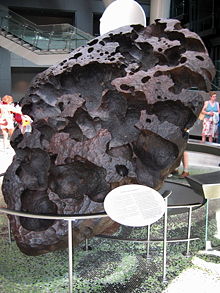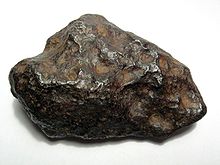- Iron meteorite
-
 The Willamette Meteorite on display at the American Museum of Natural History. It weighs about 32,000 pounds or 14.15 tonnes. This is the largest meteorite ever found in the United States.
The Willamette Meteorite on display at the American Museum of Natural History. It weighs about 32,000 pounds or 14.15 tonnes. This is the largest meteorite ever found in the United States.
 Widmanstätten pattern as seen on an etched and polished slice of the Seymchan meteorite. Scale unknown.
Widmanstätten pattern as seen on an etched and polished slice of the Seymchan meteorite. Scale unknown.
 A 1.7 kg individual meteorite from the 1947 Sikhote-Alin meteorite shower (coarsest octahedrite, class IIAB). This specimen is about 12 cm wide.
A 1.7 kg individual meteorite from the 1947 Sikhote-Alin meteorite shower (coarsest octahedrite, class IIAB). This specimen is about 12 cm wide.
Iron meteorites are meteorites that consist overwhelmingly of nickel-iron alloys. The metal taken from these meteorites is known as meteoric iron and was one of the earliest sources of usable iron available to humans.
Contents
Occurrence
While they are fairly rare compared to the stony meteorites, comprising about 5.7% of witnessed falls, they have historically been heavily over-represented in meteorite collections.[3] This is due to several factors:
- They are easily recognized as unusual even by laymen, as opposed to stony meteorites. Modern-day searches for meteorites in deserts and Antarctica yield a much more representative sample of meteorites overall.
- They are much more resistant to weathering.
- They are much more likely to survive atmospheric entry, and are more resistant to the resulting ablation. Hence they are more likely to be found as large pieces.
In fact, iron meteorites account for almost 90% of the mass of all known meteorites, about 500 tons. All the largest known meteorites are of this type, including the largest—the Hoba meteorite.
Origin
Iron meteorites have been linked to M-type asteroids since both types of objects have similar spectral characteristics in the visible and near-infrared wavelength regions. Iron meteorites are thought to be the fragments of the cores of larger ancient asteroids that have been shattered by impacts. The heat released from the radioactive decay of the short-lived nuclides 26Al and 60Fe is considered as a plausible cause for the melting and differentiation of their parent bodies in the early solar system.[4][5] The IIE chemical class may be a notable exception, in that they probably originate from the crust of S-type asteroid 6 Hebe.
Chemical and isotope analysis indicates that at least about 50 distinct parent bodies were involved. This implies that there were once at least this many large, differentiated, asteroids in the asteroid belt – many more than today.
Composition
The overwhelming bulk of these meteorites consists of the Fe,Ni-alloys kamacite and taenite. Minor minerals, when occurring, often form rounded nodules of troilite or graphite, surrounded by schreibersite and cohenite. Schreibersite and troilite also occur as plate shaped inclusions, which show up on cut surfaces as cm-long and mm-thick lamellae. The troilite plates are called Reichenbach lamellae.[6]
The chemical composition is dominated by the elements Fe, Ni and Co, which make up more than 95%. Ni is always present; the concentration is nearly always higher than 5% and may be as high as about 25%.[7] A significant percentage of nickel can be used in the field to distinguish meteoritic irons from man-made products, which usually contain lower amounts of Ni, but it is not enough to prove the meteoritic origin (e.g. some US coins).
Use
The iron nickel alloy was used by several cultures for the manufacturing of tools and weapons. For example the Inuit used parts of the Cape York meteorite.[8][9][10] Fragments from Gibeon were used for centuries by Nama people. There are also reports of their use for manufacture of various items in Tibet (see Thokcha).
Today meteoritic iron is used in niche jewellery and knife production, but most of it is used for research, educational or collecting purposes.
Classification
Two classifications are in use: the classic structural classification and the newer chemical classification.[11]
Structural classification
The older structural classification is based on the presence or absence of the Widmanstätten pattern, which can be assessed from the appearance of polished cross-sections that have been etched with acid. This is connected with the relative abundance of nickel to iron. The categories are:
- Hexahedrites (H): low nickel, no Widmanstätten pattern, may present Neumann lines;
- Octahedrites (O): average to high nickel, Widmanstätten patterns, most common class. They can be further divided up on the basis of the width of the kamacite lamellae from coarsest to finest.[12]
- Coarsest (Ogg): lamellae width > 3.3 mm
- Coarse (Og): lamellae width 1.3-3.3 mm
- Medium (Om): lamellae width 0.5-1.3 mm
- Fine (Of): lamellae width 0.2-0.5 mm
- Finest (Off): lamellae width < 0.2 mm
- Plessitic (Opl): a transitional structure between octahedrites and ataxites[13]
- Ataxites (D): very high nickel, no Widmanstätten pattern, rare.
Chemical classification
A newer chemical classification based on the proportions of the trace elements Ga, Ge and Ir separates the iron meteorites into classes corresponding to distinct asteroid parent bodies[14]:
- IA: Medium and coarse octahedrites, 6.4-8.7% Ni, 55-100 ppm Ga, 190-520 ppm Ge, 0.6-5.5 ppm Ir, Ge-Ni correlation negativ.
- IB: Ataxites and medium octahedrites, 8.7-25% Ni, 11-55 ppm Ga, 25-190 ppm Ge, 0.3-2 ppm Ir, Ge-Ni correlation negativ.
- IC:
- IIA: Hexahedrites, 5.3-5.7% Ni, 57-62 ppm Ga, 170-185 ppm Ge, 2-60ppm Ir.
- IIB: Coarsest octahedrites, 5.7-6.4% Ni, 446-59 pm Ga, 107-183 ppm Ge, 0.01-0.5 ppm Ir, Ge-Ni correlation negativ.
- IIC: Plessitic octahedrites, 9.3-11.5% Ni, 37-39 ppm Ga, 88-114 ppm Ge, 4-11 ppm Ir, Ge-Ni correlation positiv
- IID: Fine to medium octahedrites, 9.8-11.3%Ni, 70-83 ppm Ga, 82-98 ppm Ge, 3.5-18 ppm Ir, Ge-Ni correlation positiv
- IIE: octahedrites of various coarseness, 7.5-9.7% Ni, 21-28 ppm Ga, 60-75 ppm Ge, 1-8 ppm Ir, Ge-Ni correlation absent
- IIG:
- IIF:
- IIIAB: Medium octahedrites, 7.1-10.5% Ni, 16-23 ppm Ga, 27-47 ppm Ge, 0.01-19 ppm Ir
- IIICD: Ataxites to fine octahedrites, 10-23% Ni, 1.5-27 ppm Ga, 1.4-70 ppm Ge, 0.02-0.55 ppm Ir
- IIIE: Coarse octahedrites, 8.2-9.0% Ni, 17-19 ppm Ga, 3-37 ppm Ge, 0.05-6 ppm Ir, Ge-Ni correlation absent
- IIIF: Medium to coarse octahedrites, 6.8-7.8% Ni,6.3-7.2 ppm Ga, 0.7-1.1 ppm Ge, 1.3-7.9 ppm Ir, Ge-Ni correlation absent
- IVA: Fine octahedrites, 7.4-9.4% Ni, 1.6-2.4 ppm Ga, 0.09-0.14 ppm Ge, 0.4-4 ppm Ir, Ge-Ni correlation positiv
- IVB: Ataxites, 16-26% Ni, 0.17-0.27 ppm Ga, 0,03-0,07 ppm Ge, 13-38 ppm Ir, Ge-Ni correlation positiv
- Ungrouped meteorites. This is actually quite a large collection (about 15% of the total) of over 100 meteorites which do not fit into any of the larger classes above, and come from about 50 distinct parent bodies.
Magmatic and primitive irons
The iron meteorites can be divided into two classes: magmatic irons and non magmatic or primitive irons.
Iron class Groups Primitive iron meteorites IAB, IIE, Udei Station grouplet, Pitts grouplet, sLL, sLM, sLH, sHL, sHH Magmatic iron meteorites IC, IIAB, IIC, IID, IIF, IIG, IIIAB, IIIE, IIIF, IVA, IVB See also
- Hraschina meteorite
- Meteoritics
References
- ^ Tamentit meteorite at Meteoritical Bulletin Database.
- ^ Chinga meteorite at Meteoritical Bulletin Database.
- ^ Emiliani, Cesare (1992). "Meteorites". Planet earth: cosmology, geology, and the evolution of life and environment. Cambridge University Press. p. 152. ISBN 9780521409490. http://books.google.com/?id=QDU7AAAAIAAJ&pg=PA152.
- ^ Sahijpal, S.; Soni, P.;Gagan, G. (2007). "Numerical simulations of the differentiation of accreting planetesimals with 26Al and 60Fe as the heat sources". Meteoritics & Planetary Science 42 (9): 1529–1548. Bibcode 2007M&PS...42.1529S. doi:10.1111/j.1945-5100.2007.tb00589.x.
- ^ Gupta, G.; Sahijpal, S. (2010). "Differentiation of Vesta and the parent bodies of other achondrites". J. Geophys. Res. (Planets) 115 (E8). Bibcode 2010JGRE..11508001G. doi:10.1029/2009JE003525.
- ^ J. G. Burke, Cosmic Debris: Meteorites in History. University of California Press, 1986.
- ^ J. T. Wasson, Meteorites: Classification and Properties. Springer-Verlag, 1974.
- ^ Iron and steel in ancient times by Vagn Fabritius Buchwald - Det Kongelige Danske Videnskabernes Selskab 2005
- ^ T. A. Rickard (1941). "The Use of Meteoric Iron". The Journal of the Royal Anthropological Institute of Great Britain and Ireland (Royal Anthropological Institute of Great Britain and Ireland) 71 (1/2): 55–66. doi:10.2307/2844401. JSTOR 2844401.
- ^ Buchwald, V. F. (1992). "On the Use of Iron by the Eskimos in Greenland". Materials Characterization 29 (2): 139–176. doi:10.1016/1044-5803(92)90112-U. JSTOR 2844401.
- ^ Vagn F. Buchwald, Handbook of Iron Meteorites. University of California Press, 1975.
- ^ James H. Shirley,Rhodes Whitmore Fairbridge, Encyclopedia of planetary sciences, Springer, 1997. ISBN 9780412069512
- ^ Geochimica et cosmochimica acta, Volume 45, Ed. 9-12
- ^ John T. Wasson: Meteorites. Springer-Verlag 1974.
External links
Categories:- Meteorite minerals
- Meteorite types
Wikimedia Foundation. 2010.


